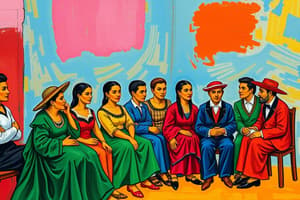Podcast
Questions and Answers
¿Qué aspecto es un sello distintivo de muchas tradiciones culinarias latinoamericanas según el texto?
¿Qué aspecto es un sello distintivo de muchas tradiciones culinarias latinoamericanas según el texto?
- Cocina tradicional
- Técnicas culinarias europeas
- Uso de ingredientes frescos y locales (correct)
- Ingredientes artificiales
¿Qué papel desempeñan las tradiciones culinarias en América Latina en términos de unidad comunitaria?
¿Qué papel desempeñan las tradiciones culinarias en América Latina en términos de unidad comunitaria?
- Unificación de la familia
- Expresión simbólica de la cultura (correct)
- División de las comunidades
- Aislamiento social
¿Qué importancia tiene la comida en las tradiciones culinarias latinoamericanas según el texto?
¿Qué importancia tiene la comida en las tradiciones culinarias latinoamericanas según el texto?
- Mera alimentación sin valor cultural
- Exclusividad para la élite social
- Desprecio por las tradiciones culinarias
- Preservación cultural y celebración (correct)
¿Qué característica se destaca en cuanto a la cocina innovadora en América Latina según el texto?
¿Qué característica se destaca en cuanto a la cocina innovadora en América Latina según el texto?
¿Cuál de las siguientes afirmaciones es cierta sobre las costumbres alimenticias mencionadas en el texto?
¿Cuál de las siguientes afirmaciones es cierta sobre las costumbres alimenticias mencionadas en el texto?
¿Cuál es uno de los elementos más prominentes de las tradiciones culinarias latinoamericanas según el texto?
¿Cuál es uno de los elementos más prominentes de las tradiciones culinarias latinoamericanas según el texto?
¿Qué papel desempeñan los alimentos tradicionales en la identidad cultural de América Latina?
¿Qué papel desempeñan los alimentos tradicionales en la identidad cultural de América Latina?
¿Por qué es importante compartir el conocimiento culinario tradicional según el texto?
¿Por qué es importante compartir el conocimiento culinario tradicional según el texto?
¿Cuál de los siguientes platos NO se menciona como parte de la cocina tradicional mexicana?
¿Cuál de los siguientes platos NO se menciona como parte de la cocina tradicional mexicana?
¿Qué tipo de influencias se fusionan en la cocina cubana según el texto?
¿Qué tipo de influencias se fusionan en la cocina cubana según el texto?
¿Qué técnica culinaria es característica de un asado argentino?
¿Qué técnica culinaria es característica de un asado argentino?
¿Qué impacto ha tenido la globalización en la cocina latinoamericana según el texto?
¿Qué impacto ha tenido la globalización en la cocina latinoamericana según el texto?
Flashcards are hidden until you start studying
Study Notes
Exploring Traditional Food Culture: Costumbres Alimenticias
Throughout history, food has played a vital role in shaping cultures and communities around the world. The unique, time-honored practices and customs surrounding food, known as costumbres alimenticias in Spanish, reveal much about the identity, traditions, and values of various regions. In this exploration, we'll delve into the rich heritage of traditional food culture, focusing on the distinctive aspects of costumbres alimenticias that make up the fabric of numerous Latin American countries and their diasporas.
A Taste of Latin America
Costumbres alimenticias are deeply rooted in the rich tapestry of Latin American culinary traditions. These traditions are often the result of the fusion of indigenous, African, European, and Asian influences. Some of the most prominent features of these traditions include:
- Natural ingredients: Emphasis on fresh, locally sourced, and seasonal ingredients is a hallmark of many Latin American culinary traditions.
- Innovative cuisine: Chefs and home cooks across the region have spearheaded the integration of traditional ingredients and techniques into innovative, contemporary recipes.
- Family and community: Culinary traditions are often an expression of family bonding and community unity.
- Food as a means of cultural preservation: Traditional dishes, prepared and enjoyed in unique ways, are a vital means of preserving and celebrating cultural heritage.
The Importance of Traditional Foods
Food plays a significant role in Latin American cultural identity. Traditional dishes provide a tangible connection to the past, honoring the customs, traditions, and heritage of ancestors. Additionally, traditional food staples offer essential nutrients and serve as a source of pride for local communities. The sharing of traditional culinary knowledge is an act of solidarity and unity.
Regional Cuisine
Latin America boasts an incredibly diverse array of traditional cuisines, each one a testament to the region's rich history and unique cultural heritage.
- Mexico: Corn is a staple food in Mexican cuisine, and traditional dishes like tacos, enchiladas, and mole are beloved worldwide.
- Peru: The diverse cuisine of Peru is considered one of the world's best, with dishes like ceviche, lomo saltado, and anticuchos reflecting the country's unique history.
- Cuba: Cuban cuisine is a fusion of Spanish, African, Chinese and indigenous Taino influences, with dishes like ropa vieja, arroz con pollo, and frituras being particularly popular.
- Argentina: Asado, a traditional Argentinian barbecue, is a beloved culinary tradition, while empanadas are enjoyed across the country.
- Colombia: Colombia's rich culinary heritage includes dishes like bandeja paisa, sancocho, and arepas.
The Future of Costumbres Alimenticias
As the world becomes increasingly interconnected and globalized, Latin American cuisine is gaining in popularity worldwide. The fusion of traditional ingredients, techniques, and recipes with contemporary flavors and cooking styles is making the culinary traditions of Latin America more accessible and appealing to a wider audience. This fusion of traditional and modern culinary techniques is allowing chefs and home cooks to innovate and create new dishes that honor their roots while appealing to a global palate.
In conclusion, the costumbres alimenticias of Latin America are a testament to the rich cultural heritage of the region. By exploring the unique culinary traditions of various countries, we can gain a deeper appreciation of the region's history, identity, and the role that food plays in shaping and preserving cultural heritage. Whether exploring the vibrant and spicy dishes of Mexico or the hearty and flavorful cuisine of Argentina, there is always something new to discover and enjoy in the world of Latin American culinary traditions.
Studying That Suits You
Use AI to generate personalized quizzes and flashcards to suit your learning preferences.




